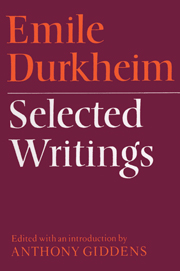Book contents
- Frontmatter
- Contents
- Preface
- Abbreviations
- Introduction: Durkheim's writings in sociology and social philosophy
- 1 The field of sociology
- 2 Methods of explanation and analysis
- 3 The science of morality
- 4 Moral obligation, duty and freedom
- 5 Forms of social solidarity
- 6 The division of labour and social differentiation
- 7 Analysis of socialist doctrines
- 8 Anomie and the moral structure of industry
- 9 Political sociology
- 10 The social bases of education
- 11 Religion and ritual
- 12 Secularisation and rationality
- 13 Sociology of knowledge
- Index
2 - Methods of explanation and analysis
Published online by Cambridge University Press: 05 August 2012
- Frontmatter
- Contents
- Preface
- Abbreviations
- Introduction: Durkheim's writings in sociology and social philosophy
- 1 The field of sociology
- 2 Methods of explanation and analysis
- 3 The science of morality
- 4 Moral obligation, duty and freedom
- 5 Forms of social solidarity
- 6 The division of labour and social differentiation
- 7 Analysis of socialist doctrines
- 8 Anomie and the moral structure of industry
- 9 Political sociology
- 10 The social bases of education
- 11 Religion and ritual
- 12 Secularisation and rationality
- 13 Sociology of knowledge
- Index
Summary
EMERGENT PROPERTIES
Whenever any elements combine and, by the fact of their combination produce new phenomena, it is evident that these phenomena are not given in the elements, but in the totality formed by their union. The living cell contains nothing but mineral particles, just as society contains nothing but individuals; it is obviously impossible, however, for the phenomena characteristic of life to exist in the atoms of hydrogen, oxygen, carbon, and nitrogen. For how could the properties of life exist within inanimate elements? How, moreover, would the biological properties be divided among these elements? These properties could not exist equally in all the elements because the latter are different in nature; carbon is not nitrogen and consequently can neither possess the same properties nor have the same role. It is similarly inadmissible that each of the principal aspects or characteristics of life be manifest in a different group of atoms. Life could not thus be subdivided; it is a unity, and consequently its basis be only the living substance in its totality. It is in the whole, not in the parts. The inanimate particles of the cell do not feed themselves, reproduce – in a word, live – only the cell itself can do so. What we say of life could be repeated for any type of compound. The hardness of bronze is not in the copper nor in the tin, nor the lead, which served to create it, and which are soft and malleable bodies; it is in their mixture.
Information
- Type
- Chapter
- Information
- Emile Durkheim: Selected Writings , pp. 69 - 88Publisher: Cambridge University PressPrint publication year: 1972
Accessibility standard: Unknown
- 1
- Cited by
